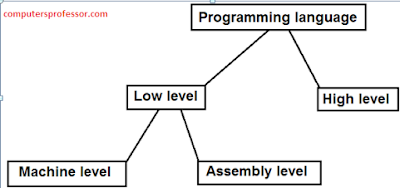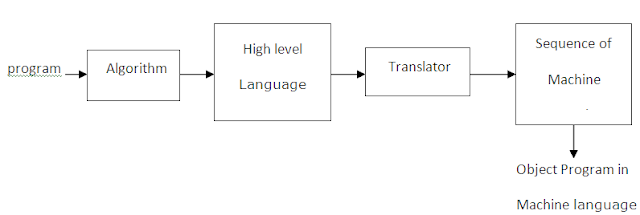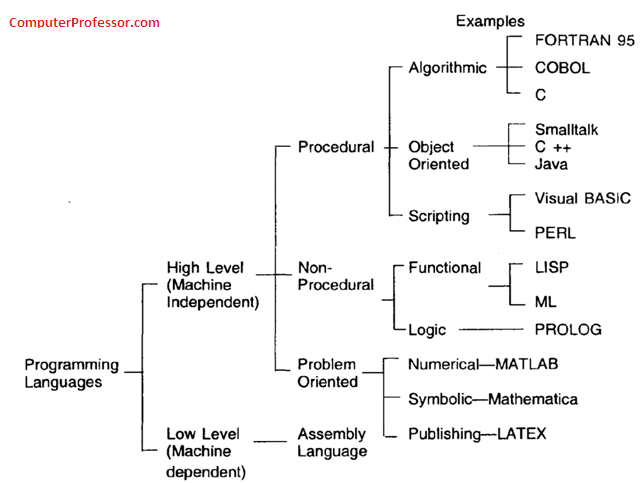Write About Programming Languages?
https://www.computersprofessor.com/2016/05/write-about-programming-languages.html
Programming languages :
To communicate users languages are used
Languages are 2 types
1.
natural language
2.
programming language
Natural languages are used to communicate users.
ex : Telugu, English, etc
Programming languages are used to communicate user &
computer.
Programming languages are divided into 2 types.
Machine Level Language
:
In order to write a machine language program, a programmer
has to remember all the operation codes of the computer and know in details
what each code does and how it affects various registers in the processor.
The main purpose of using computers
is to solve problems computer user to concentrate on the development of good
algorithms for solving problems rather than be concentrated with the details of
the internal structure of the
computer.
Assembly
Language:
In
An assembly language, mnemonics are used to represent operation codes, and
strings of characters to represent address. An assembly language is designed
mainly to replace each machine code with an understandable mnemonic and each
address with a simple alphanumeric string; it is matched to a particular
computer’s processor structure. It is thus machine
dependent. It is necessary for an assembly language programmer to know all
details of a computer’s logical structure in order to write a program.
In
order to execute an assembly language program on a computer, it should first be
translated to its equivalent machine language program. The mnemonic operation
codes should
be converted to absolute numeric operation codes. The symbolic
addresses of operands used in assembly language should also be converted to
absolute numeric address. The translator which does this is known as an assembler.
The
input to an assembler is the assembly language program and is known as the source program. Its output is the
equivalent machine language program and is known as object program. The assembler is a system program which is supplied
by the computer manufacturer.
The
main advantage of using an assembly language for programming is the efficiency
of the machine language program resulting from it.
The
main disadvantages of assembly languages are:
a. It
is machine-dependent. Thus program written in one model of a computer cannot be
executed on another model.
b. An
assembly language programmer must be an expert who knows all about the logical
structure of the computer for which the program is written.
c.
Writing assembly language programs
is difficult and time-consuming.
High Level Programming Languages:
v
Algorithms are used to solve a problem
v
Algorithms are written in natural languages
v
Easy to write
v
Describe the nature of the data to be processed
v
Operators, control structures are used to solve
a problem
v
High level languages are machine independent and
need not to know internal structure of the computer.
High
level languages are designed independent of the structure of a specific
computer.
This facilitates executing a program written in such a language on
different computers.
Each high level language is a program which translates it
into the machine language of
the computer.
There
are two approaches to writing language translators. One method is to take one
statement of a high level language at a time and translate it into a machine
instruction which is immediately executed. This is called an interpreter. The other approach of
translation is to store the high level language program, scan it and translate
the whole program into an equivalent machine language program. Such a
translator is known as compiler.
Some
High Level Languages:
Fortran:
FORTRAN
stands for Formula Translation. The language was designed to solve scientific
and engineering problems and is currently the most popular language among
scientists and engineers.
Cobol:
COBOL
stands for Common Business Oriented Language. COBOL is widely used programming
language for business data processing.
Pascal:
The
primary aim of providing a language which allows beginners to learn good
problem solving and programming methods. Pascal has facilities to manipulate,
not only numbers, but also vectors, matrices, strings of characters.
C Language:
C
has been designed so that it has the advantages of a high level language,
namely, machine independence. At the same time it providing only the bare
essentials required in a language so that a translator it into an efficient
machine language code. The first major use of C was to write an operating
system known as UNIX. An aspect of C which makes it a powerful programming
language is the access to the addresses in memory where variables are stored.
Why
has C become popular? The reasons are:
1. It
is flexible and can be used to program a variety of application.
2. It
is efficient in the sense that the object code produced is concise. This is due
to the fact that C is closer to machine language semantics.
3. C
compilers are widely available and inexpensive.
C++ Language:
An
object oriented version of C called C++ is the most popular OOP language. In an
Object Oriented Program (OOP) an object is modeled by a collection of data
structures and a set of procedures that can be performed on this data
structure. It was designed as an extension of C and its popularity is mostly
due to the popularity of C.
Java:
Which
is an object oriented language. This language achieves machine independence by
defining a Java Virtual Machine for
which the compiler is written. By a virtual machine we mean a non-existent
machine. Java is getting wide acceptance now as programming language to write
applications for a network of heterogeneous computers.
Scripting Languages:



































Thank for explaining in brief.
ReplyDelete